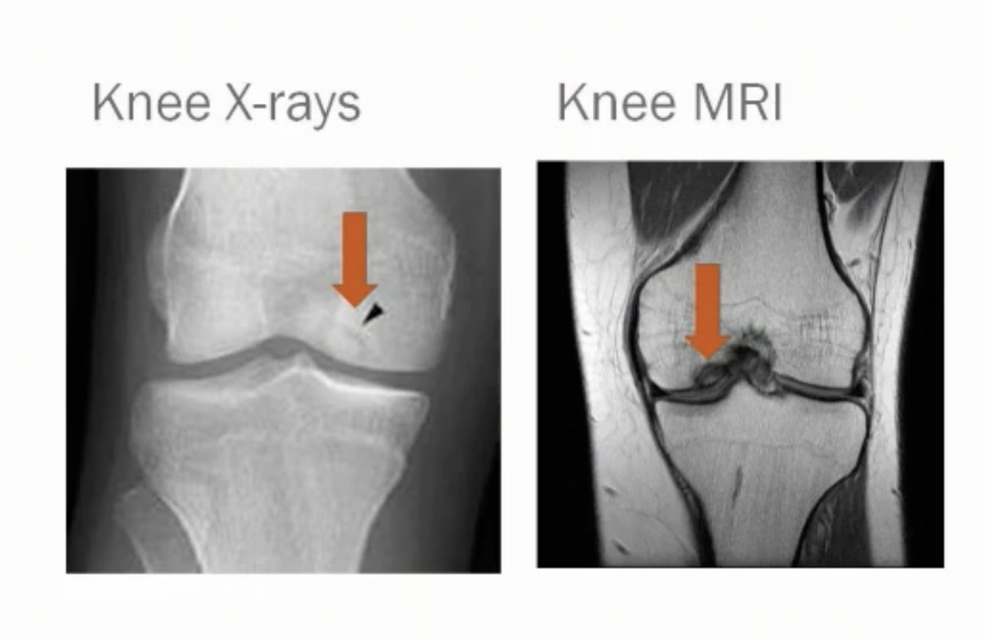Osteochondritis Dissecans
July 21, 2022
Hello, and welcome to Yuma Health and Happenings. I’m Dr. Ron Clark, Orthopedic Surgeon and founder of The Bone and Joint Center of Yuma. Today, I want to talk about injuries to the bones around the knee and an unusual condition with an odd name: osteochondritis dissecans.
This condition generally involves individuals between the ages of 10–15 years but can also be found in adults. It’s unknown whether the condition begins during adolescence and ultimately becomes symptomatic in adult life. With this condition, the bone cartilage around the knee surface will suddenly die and then collapse, causing pain. Its cause is not well understood, and there are no precautions you can take to avoid experiencing the condition.
Where Does Osteochondritis Dissecans Occur?
The knee is composed of three bones. Osteochondritis dissecans almost always occurs in the inside portion of the thigh bone or femur. Unlike osteonecrosis, the area of involvement is usually limited, and pain is not generally severe. Most of the time, an individual will notice “catching” or discomfort with high-intensity activities, like sports. The disease occurs when a portion of the bone loses its blood supply and dies. Since bone is a living structure, if the blood supply is stopped, it will not be able to maintain its strength and will eventually collapse. The affected area is close to the joint surface and can be described as a loose piece of tile on a countertop, which explains the mechanical symptoms of the condition.
Patients who have this condition fall into one of three categories. The first is those patients where the joint surface is still completely intact. The second group has a disruption of the joint surface, but the damaged surface is not floating free in the joint. In the case of the last group, the damaged fragment is completely free from the surrounding bone.
Early during the condition, X-rays of the knee are normal, and the symptoms are mild. With time, X-rays will show a rim of bone close to the joint surface has become separated from the normal surface. Often, the diagnosis takes several weeks because rest and medication will not relieve the pain, and repeat visits to the physician are needed. An MRI is used to form the diagnosis, as there are clear changes that are visible on the scan. Once the diagnosis is uncovered, there are a few treatment options available for the patient.
Treatment for Osteochondritis Dissecans
For those individuals younger than 16, rest and casting are recommended, as there is an 85% chance that healing can happen without the need for surgery. Unfortunately, at this young age, such rest can be very difficult to enforce. Most situations will improve within 2–4 months of rest. Then activities can be steadily resumed. In situations where the portion of the bone is significant or loosening of the fragment has already occurred, surgery may be necessary to stabilize the fragment. In adults, there is little to no chance of healing, so surgery is generally recommended at the time of diagnosis.
Surgical options for treating osteochondritis dissecans aim to stabilize the fragment and encourage it to heal back to the rest of the bone, preserving the smooth joint surface that is attached to the damaged bone. Most of these procedures are performed through a small surgical viewing scope, called an arthroscope, and can be done on an outpatient basis. These procedures may involve drilling channels in the bone to encourage healing; applying screw implants to secure the fragment to the bone; or transplanting healthy bone and cartilage into the defect to prevent the occurrence of arthritis in the future.
Recovery after surgery usually requires 2 months of rest and crutch use, so it may be 5 or 6 months before high-demand sporting activities are possible. The success rate of surgery is high in young individuals and adults, but the younger the individual is, the better the odds for a successful recovery. Major procedures such as joint replacement surgery are not used in young people and are rarely needed as an initial treatment in adults, but they may be considered for large, advanced areas of damage in people over 60.
Since the success of treatment is so high, the key to appropriately caring for osteochondritis dissecans is the prompt diagnosis by an orthopedic surgeon. Parents should not allow their children to ignore knee problems. Any knee problem that causes swelling, locking, or catching sensations in the joint should be immediately evaluated by an orthopedic surgeon.
Because this condition is quite rare and not well understood, patients may have the condition for several months before the diagnosis is actually made. There are several other conditions, such as sprains, stress fracture, overuse, meniscus cartilage tears, and infections, that may cause similar symptoms in the knee, so a complete medical history and examination should be performed. With the increased use and availability of MRI scanners, the diagnosis is more easily found.
This is not a condition that one can diagnose on their own, so if you or a loved one has severe, persistent knee pain, visit an orthopedic surgeon.